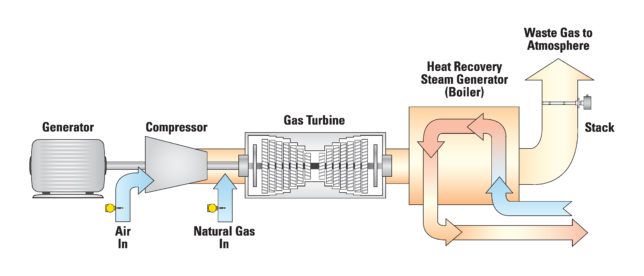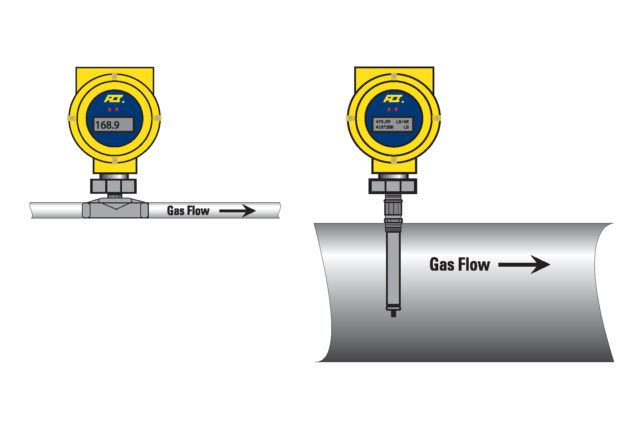AIR AND GAS FLOW MEASUREMENT
HOW TO CHOOSE THE BEST TECHNOLOGY
FOR YOUR TURBOMACHINERY APPLICATIONS
By Art Womack, Fluid Components International

The accurate, repeatable flow measurement of air and gases is critical to the safe, efficient and cost-effective operation of turbomachinery. There are at least nine common industrial flow measurement technologies available today. All have their strengths and weaknesses. Understanding these flow sensing technologies prevents costly mistakes.
Flow meters often measure both the fluid flow rate and total flow. Given the operating environment of electric power plants and oil & gas refineries, flow meters generally require hazardous area approvals and often must be IEC 61508/61511 (SIL) compliant as part of a Safety Instrumented System (SIS). The most common turbomachinery flow measurement applications involve turbines and compressors.
Accurate and consistent air and gas flow measurement over a wide turndown range is particularly important in the electric power industry for steam driven turbine systems, including combined cycle gas turbines (CCGT), combined heat and power (CHP), and co-generation systems using waste gases.
Repeatable measurement of the air-to-gas fuel mixture supports efficient boiler operations to generate steam as needed. Monitoring of the mass flow rate of hydrogen in cooling systems allows early detection of leaks to minimize environmental impact. The ability to operate over a wide turndown range is important to support variable power demand.
Similarly, the operation of these compressor stations requires accurate natural gas flow measurement from the pipeline. Monitoring the health of dry gas seals, which serve as a back-up leakage system to prevent the gas from accidentally leaking into the atmosphere, can also reduce operational costs.
Challenges
Gas flow measurement in turbomachinery applications can present many technical challenges. Sensitivity to low-flow conditions is required to identify and measure gas leaks that deviate from the normal low-flow condition in day-to-day operations.
Process upset conditions may cause high flows, requiring a meter capable of measuring flow accurately over a wide turndown range.
Many gas turbine and compressor applications require flow meter calibrations specific to the particular hydrocarbon composition in the gas. Matching the flow meter’s calibration to actual process conditions with actual gas mixtures is essential.
In some applications, gas mixture variations periodically occur and require multiple calibration groups that can be called upon for improved repeatability.
Two methods are used in calibrating air and gas flow meters:
• The direct method, where the meter is calibrated to a specific pure process gas and/or to the actual components of a mixed gas
• The air equivalency method, where the meter is calibrated using air, and then the calibration is adjusted with a pre-defined correction factor.
Flow meter accuracy is improved when calibrations use actual gas mixtures and process conditions that best represent field conditions. Air equivalencies can be given consideration when there is sufficient data to support its use or it is unsafe to use the actual process media.
As pipe sizes increase, the number of effective flow meter technologies decreases. Few are capable of accurate measurement in air and gas lines supporting large turbomachinery equipment and processes. Single point measurements will introduce greater inaccuracies as line sizes increase.
All velocity-based flow meter technologies have straight-run pipe requirements upstream and downstream from the meter to achieve accurate flow measurement. These straight-run requirements may not be available in crowded production sites and process plants, especially when larger lines are involved.
Access, too, has to be considered. Access to piping for installation, maintenance or servicing is often difficult. For example, spool-piece (inline) flow meters can require prolonged process shut-downs and extensive on-site labor costs to install and continuously maintain the system.
Insertion style meters, on the other hand, can be easily inserted into or retracted out of the process through a single isolation ball valve.
When installing meters in hazardous locations, the entire flow metering instrument should carry agency approvals that demonstrate suitability for installation in environments with potentially explosive gases; enclosure-only ratings are inadequate. Acceptable approvals can vary globally and may further limit your options.
Measurement technologies
The fluid being measured typically determines the type of measurement — volumetric or mass flow. Liquids are primarily measured in terms of volumetric flow, while mass flow measurement is often preferred for air and gas because of the properties and compressibility of gases.
While some volumetric technologies can measure air and gas flow rates, there can be limitations in the measurement of total flow.
Coriolis
The principle of operation for Coriolis flow meters relies on a vibrating tube where the flow of a fluid causes changes in frequency, phase shift or amplitude proportional to the mass flow rate.
Coriolis meters are accurate and frequently used in custody-transfer applications. But they can be expensive, especially in larger line sizes, and often require bypass piping systems to accommodate field maintenance.
Differential Pressure (DP)
DP transmitters are often paired with primary flow elements such as orifice plates, averaging pitot tubes and Venturis. The typical DP meter design requires the fluid to move through or past two points of reference, creating a differential pressure rate equivalent to the rate of flow using the Bernoulli equation with some modifications.
If the fluid is dirty, orifice, impulse tubing and manifold blockage can occur that requires maintenance to maintain accuracy. Turndown capability can be limited if a single transmitter is used.
Ultrasonic
Meters designed with ultrasonic flow sensing technology rely on ultrasound and the Doppler Effect to measure volumetric flow rate. A transducer emits a beam of ultrasound to a receiving transducer.
The transmitted frequency is altered linearly by particles or bubbles in the fluid stream. The shift in frequencies between the transmitter and receiver can be used to generate a signal proportional to the flow rate.
Optical
Flow meters designed with optical sensing rely on laser technology and photo detectors. They require the presence of particles in the gas stream to scatter the light beam. The time it takes for these particles to travel from one laser beam to the other laser beam can be used to calculate the gas velocity and volumetric flow rate. These meters have good accuracy, and wide turndown but can be expensive.
Thermal Dispersion
Flow meters with thermal dispersion sensors provide direct mass flow measurement. Two thermowell protected platinum resistance temperature sensors (RTD) are placed in the process stream.
One RTD is heated while the other RTD senses the actual process temperature. The temperature difference between these sensors generates a voltage output proportional to the media cooling affect and can be used to measure the gas mass flow rate without the need for additional pressure or temperature transmitters.
Installation
When choosing a technology, another concern is the intended meter location and the manufacturer’s installation requirements. Most flow meter technologies require a stable flow velocity profile upstream and downstream from the point of meter installation; a specific number of pipe diameters in each direction.
Flow sensors are potentially sensitive to swirling conditions and velocity profile distortions created by obstructions before and after the metering point.
Irregular flow profiles can be addressed with flow conditioners. There are various types of flow conditioners that can be inserted strategically in the pipe to straighten the flow before it reaches the flow sensor.
They consist of tabs, perforations, tube bundles, vanes or other designs, which all straighten the flow to some extent. Some straighteners, such as the tab type, actually speed up the rate of flow by creating vortices, also minimizing head loss (pressure drop).
Spool type flow meters are installed as a section of the process piping. Insertion flow meters are mounted through a tap point to the pipe section. Some flow meters can only be installed using one method. Coriolis meters must be installed inline (part of the piping). Thermal meters, some DP meters (orifice plates and averaging pitot tubes), and others can be installed in either inline or insertion configurations. ■

Inline versus insertion flow meter installations